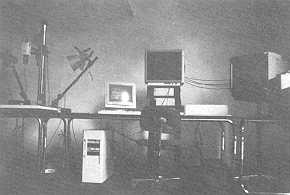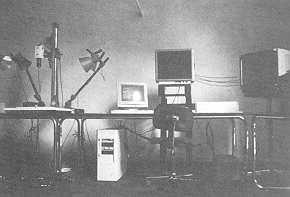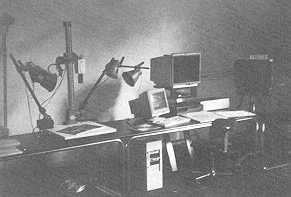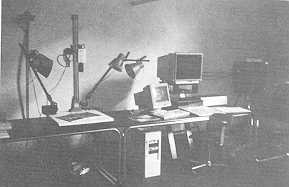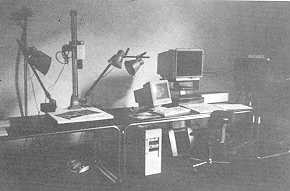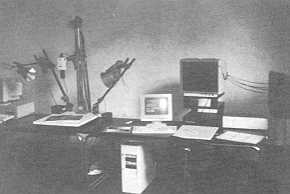| Annals of the MBC - vol. 4 - n* 2 - June 1991
VIDEOGRAPHIC TECNOLOGIES - AN APPLICATION IN THE MEDICAL FIELD
Pasotto P. *, Masellis M.
Divisione di Chirurgia Plastica e Terapia delle Ustioni,
Ospedale Civico, Palermo, Italia
* Sinopia Informatica, Bologna, Italia
SUMMARY. 'An account is given of
how the new technologies of information science, and in particular videographics, can be
useful in the medical field. Sinopia Informatica and MBC have jointly set up a
technological laboratory which will permit strategic adjustment to new professional
demands and the progressive realization of a valuable image-bank. The technical details
and other advantages are described.
The technological boom stimulated the
search for new analyses and solutions, the prime impetus coming from industry with its
continuous breakthroughs. Rapid progress was made and many colleagues and institutions
were left by the wayside because of their unwillingness to accept the everchanging rules
of technological innovation. Now things have begun to calm down and there is time to pause
for reflexion: in the field of training, as in other areas, the traditional figures are
beginning to process all that is new and to use the new technologies "wisely".
The very concepts of "interactivity" and "multimediality", which
before. were familiar terms without in fact. ever being processed, verified, or fully
accepted, are today being experimented with on a much larger scale, also because they now
belong to our everyday way of making use of information.
The new technologies offer. incredible scope in the way of applications and instruments.
This article will describe one of these applications, or rather a methodology of
application, which has developed out of the collaboration between the technical staff of
Sinopia Informatica, a company that specializes in the new technologies applied to
communication and training, and the MBC scientific and medical team.
In this methodology a decisive role is played by videoinformatic technologies, in which
the video-image is of prime importance. The most interesting features are perhaps the way
the image can be used by the different media, together with the ease of management, with
the various kinds of software, of the image-banks, which can be rapidly updated and,
thanks to their optical memories, are of considerable capacity.
The graphic computer permits multiple possibilities for the realization and treatment of
images, which allows dynamic and elastic management of this communicative support in
training.
With an AT personal computer and an AT&T graphic card it is possible to use up to
32,000 colours, with the option of special effects and of the acquisition by telecamera of
any type of image (digitalization), which can then be processed or modified,
With pictorial graphics software it is possible to experiment directly with different
solutions as to the colour and shape of a design; it is also possible to create
image-banks manageable with a database and oriented at the formation of data-banks which
can be used as the basis for later production of a yideodisc or an interactive
presentation or self-training programme.
The most specific t , echnique of computer graphics is animation, with considerable
flexibility of application. The visual simulation of processes that would be difficu.1t to
represent by any other means makes it possible to produce audiovisuals of great didactic
and communicative potentiality.
The visualization of data (business graphics) is another particularly interesting
technical possibility as it considerably reduces the time necessary for the production of
diagrams, "cake" diagrams and any kind of graph for statistical tables.
An example of this integration between the different media mentioned above and the various
functional applications is represented by Sinopia Informatica and MBC's joint realization
of a. technological laboratory at the Department of Plastic Surgery and Burns Therapy at
Palermo Civic Hospital. The rational use in the laboratory of the technologies permits
strategic adjustment to new professional demands and at the same time the progressive
realization of an image-bank~ which will become the support not only for the
professionality of the staff but also for , research, training and specialization.
We have created (Fig. 1) a studio in which the operators can manage the images taken by
two telecameras located in the burns operating theatre. This means that the burned part of
every patient is film ed and this becomes the "document" to be treated and
managed for the various purposes that may be required.
These telecamera analogue images are
digitalized and then recognized by the computer as information: pictorial software makes
it possible to magnify particulars, add captions and prepare montages. The Sinopia
Informatica FILTRI can accentuate contrasts, optimize even the least clear parts of an,
image, and obtain false colours; and positive or negative black-and-whites.
All these indispensable in scientific analysis. Specialized personnel intervene at this
point to select images with a view to producing didactic material for professi , onal
updating.
Ultimately the images are stored on optic drive and managed by a powerful database
(FOTO-BASE) produced by Sinopia Informatica. FOTO-BASE allows retrieval of the images
desired in a matter of moments and also makes it possible to make statistical syntheses of
bu , rn types. It is also a valuable didactic aid as the teacher is able to manage in real
time a considerable number of images which can be obtained immediately on various
supports. In this case, in the Palermo Hospital laboratory, the image can be obtained
either on Polaroid or on a slide using a film-recorder, a peripheral which - connected to
the computer - immediately develops film.s. Polaroid is used when instantaneous
verification is required, and the slide for , later projection or for printing and
publication. Colour printing is also possible with a thermal graphic printer when
illustrative material for scientific papers has to be produced at short notice.
The image can also be videorecorded using a professional VRT connected to the computer, if
the objecti , ve is a film.
Another interesting feature is that a large-screen videoprojector can be connected to the
computer for use in an adjacent lecture room where lessons or scientific meetings take
place. In this case lessons can be organized using Sinopia Informatica BANCO techniques
are VIDEO software, which makes it possible to produce all the material necessary for the
videoprojection of a report or a lesson. All this can be prepared with just. a few. hours'
work, taking advantage of the gi~cat flexibility of th~ image-bank.
This image-bank is important as documentation in progress: it is a file that is growing
over the months and is continually being verified, updated and enriched. And behind this
file,'which has already been widely used for , direct professional updating and training,
there is a project: the production of a. videodisc on bums in the Mediterranean area, with
the dual purpose of documentation and professional self-tr4ining.
This is an example of what we mean when we speak of organized and aimed initiatives, in
which the technological aspect is not seen as a separate logic of its own but as part of a
. general strategy which enhances opportunities, means, instruments and methods. Also the
videodisc and the management data base, and with them the multimedial and interactive
systems for self-mlining, are seen as the fina , I products of a process of construction
and selection of the data and image bank. In the fina , I analysis the product is bound to
have the advantages which the experts speak about and which sometimes seem unattainable:
- return of tipapcial outlay
- low-cost repeatability and transportability of the system
- speed of acpess to information.
RESUME. Les Auteurs décrivent
l'utilité des nouvelles technologies informatiques, et en particulier la vidéographique,
dans le champ médical * La Sinopia Inforrpatica et FMBC ont institué conjointement un
laboratoire technologique qui permettra I'adaptation stratégique aux nouvelles demandes
profesSI.Onelles et la réalisation progressive d'une précieuse banque d'images. Les
détails techniques et les autres avantages sont décrits.
|
